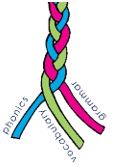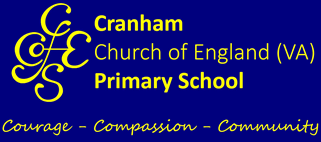Spanish Intent: How we plan for this subject...
At Cranham Primary, KS2 follow the Rachel Hawkes Primary Spanish Scheme, which draws on three key knowledge strands: phonics, vocabulary and grammar. This is supplemented with fun songs and games to engage and reinforce the learning. KS2 children are taught Spanish once a week during a 1 hour lesson. The scheme follows a 2-year rolling structure where phonics and grammar repeat in Y3 and Y4, and then again in Y5 and Y6, however the vocabulary each year varies so that the lessons themselves are different. This allows the children to build on and reinforce previous learning.
once a week during a 1 hour lesson. The scheme follows a 2-year rolling structure where phonics and grammar repeat in Y3 and Y4, and then again in Y5 and Y6, however the vocabulary each year varies so that the lessons themselves are different. This allows the children to build on and reinforce previous learning.
Long term plans from the scheme are adapted as necessary to suit the individual learning of the children each year.
Curriculum Map
Year 3/4
|
Autumn Term |
Spring Term |
Summer Term |
|
Half-term 1: Describing me and others |
Half-term 1: Saying what I and others do
|
Half-term 1: Describing things and people |
Y5/6
|
Autumn Term |
Spring Term |
Summer Term |
|
Half-term 1: Describing me and others
|
Half-term 1: Saying what I and others do |
Half-term 1: Saying what activities I and others do |
Progression and End of Year Outcomes
Language Progression: Spanish KS2 curriculum
|
Knowledge |
Modes and modalities |
Year 3 |
Year 4 |
Year 5 |
Year 6 |
|
Phonics |
Recognition & Production |
I have learnt the SSC and phonics key words and remember them. I can match the Spanish SSC I hear to print and transcribe accurately the SSC I know best. I enjoy listening to and joining in with simple songs and rhymes. |
I can link SSC to new words I hear. I listen and transcribe SSC within single words with some success. I use sound-spelling links to follow when I listen and read. I enjoy listening to and joining in with simple songs and rhymes. |
I have learnt about vowel combinations and stress patterns. I identify these when listening. I connect sound and spelling by transcribing a range of new words and parts of words. I enjoy listening to and joining in with songs and short poems. |
I can listen and write short phrases including unfamiliar words more accurately, when focusing on transcription. I enjoy listening to and joining in with songs and short poems. |
|
Recognition & Production |
I can readily read aloud the SSC and phonics key words. I can carefully sound out some unfamiliar words and parts of words with some success, focusing on a few SSC at any one time. |
I can read aloud familiar words observing certain pronunciation rules (silent letters, accent/ stress markers, etc) and some unknown words. My pronunciation is usually comprehensible. |
I can read aloud many familiar words with clear and comprehensible pronunciation. More slowly and carefully, I can decode unfamiliar words using SSC knowledge. |
I read familiar words and short sentences aloud with clear and comprehensible pronunciation. I can read aloud single unknown words more readily. |
|
|
Vocabulary |
Understanding |
I understand around 50 words when I listen and read them as single items and in short sentences which describe people, places, things and actions. |
I understand around 100 words when I listen and read them as single items and in short sentences which describe people, places, things and actions. I look words up in an alphabetical word list. |
I understand around 150 words when I listen and read them as single items and in short and compound sentences which describe people, places, things and actions. I am beginning to use the words I know in a sentence to work out likely meanings of single unknown words. I also use a dictionary. |
I understand around 200 words when I listen and read them as single items and in short and compound sentences which describe people, places, things and actions. I can use the words I know in a sentence to work out likely meanings of single unknown words. I also use a dictionary. |
|
Production (Oral (S) / Written (W)) |
I can use around 50 words to engage in short exchanges; ask and answer questions; express opinions and respond to those of others; seek clarification and help. I can speak in and write sentences about people, places, things and actions, using familiar vocabulary and basic language structures. |
I can use around 100 words to engage in short exchanges; ask and answer questions; express opinions and respond to those of others; seek clarification and help. I can speak in and write sentences about people, places, things and actions, using familiar vocabulary and basic language structures |
I can use around 150 words to engage in short exchanges; ask and answer questions; express opinions and respond to those of others; seek clarification and help. I can speak in and write sentences about people, places, things and actions, using familiar vocabulary and basic language structures. |
I can use around 200 words to engage in short exchanges; ask and answer questions; express opinions and respond to those of others; seek clarification and help. I can speak in and write sentences about people, places, things and actions, using familiar vocabulary and basic language structures. |
|
|
Grammar1 |
Understanding |
I distinguish and understand (in listening and writing) singular and plural articles (indefinite and definite), singular verbs ESTAR, SER, TENER, HAY, regular -AR and -ER , singular adjective agreement and position (-o, -a, -e, -z), regular plural noun marking (-s, -es), intonation questions, WH-questions with dónde, cómo, qué, cuántos, cuántas |
I distinguish and understand (in listening and writing) singular and plural articles (indefinite and definite), singular and plural forms of ESTAR, SER, TENER, HAY, HACER, JUGAR, regular-AR and -ER verbs, singular IR, 2-verb structures with singular QUERER, DEBER, PODER + infinitive, singular and plural adjectives (-o, -a, -e, -z, -l, -s), intonation questions, WH-questions with quién, qué, cuándo, cuál, cuántos / cuántas |
||
|
Production (Oral (S) / Written (W)) |
To describe people, places, things and actions (in speaking and writing) I use singular and plural articles (indefinite and definite), singular verbs ESTAR, SER, TENER, HAY, regular -AR and -ER , singular adjective agreement and position (-o, -a, -e, -z), regular plural noun marking (-s, -es), intonation questions, WH-questions with dónde, cómo, qué, cuántos, cuántas |
To describe people, places, things and actions (in speaking and writing) I use singular and plural articles (indefinite and definite), singular and plural forms of ESTAR, SER, TENER, HAY, HACER, JUGAR, regular-AR and -ER verbs, singular IR, 2-verb structures with singular QUERER, DEBER, PODER + infinitive, singular and plural adjectives (-o, -a, -e, -z, -l, -s), intonation questions, WH-questions with quién, qué, cuándo, cuál, cuántos / cuántas |
|||
1 The grammar features in lower KS2 (Y3/Y4) are all introduced in Y3 and revisited in new contexts in Y4 to deepen knowledge. The same applies to upper KS2 (Y5/6).
Key: L (Listening), S (Speaking), R (Reading), W (Writing)
This resource is based on Language Progression: Spanish Curriculum document (by Hawkes, Rachel), licensed under CC BY-NC-SA 4.0.
